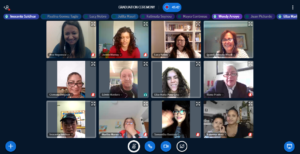This week English at Work celebrated graduation of four English training cohorts with our partners at Whole Foods Market in the North East region. The training was kicked off in late February, just when the coronavirus was aggressively making its way into communities across the greater New York City metro area: Westchester County, NY, Bergen County, NJ and the New York City’s five boroughs. These are the same areas where we enrolled dozens of Whole Foods employees from 22 stores, to participate in retail English training. Three of our cohorts were set up to meet in person at our partner community college campuses, and one remotely.
Only two weeks in, we quickly anticipated school closures and pivoted all groups to remote instruction. Fortunately, English at Work already had a remote model in place that was developed as part of preparing our program for scale. We were therefore able to move to remote instruction without any training interruption. 
But most of our participants did not sign up for remote classes. They continued to board trains and buses packed with other essential workers that kept the city and its surroundings going. They picked up extra hours or shifts and they took on the challenge of performing new work. Stay-at-home orders have brought added family responsibilities and changes in daily routines for all. One welcomed a new baby. Some were even sick or had a family member who was sick. Yet, in the face of all these challenges, they persevered. Over 70% of participants were retained in the training and their resilience and commitment to learning inspired us all. So you might wonder, what kept them coming back to class? Virtual class, that is…
Learner Support
The increased help desk support provided by the Forum staff was more important than ever. Our team typically provides ample resources and support to onboard students to our learning platform in the form of simple, easy-to-digest user guides, short video tutorials of the technology tools used, and live phone, text and email support. However, we do not rely only on our participants simply following the instructions they are sent, or even wait for troubleshooting calls, but rather provide pro-active live support. This high-touch support through outreach calls was particularly important in this round of training because it allowed us to build trust with learners, encourage and re-assure them that the virtual class will help them achieve the same learning goals they set for the in-person course. Our pro-active support strategies are informed by user log-in and activity data, along with class recordings. Furthermore, instructors create a safe-space and encourage peer-to-peer support where students can help each other, often in their native language, to troubleshoot issues that prevent them from actively participating (muting/unmuting, finding the chat, joining a breakout room, etc.)
As a result, most students thrived in this virtual environment that was completely new to them. They jumped at the opportunity to learn new skills and appreciated the added value this training brought. Several participants have shared that their goal is to become a supervisor and in that role they must be comfortable using the computer, communicating via email, or attending online meetings and this training is helping them achieve just that.
Along these lines, in her graduation remarks, Carolyn Falco, Executive Leader of Operations at Whole Foods shared: “Feedback from our store team leaders lists that our graduates have greater confidence in communicating with leadership, and with our customers, and they exhibit new knowledge and experience on utilizing computers and other technology in the stores.”
Robust remote-learning pedagogy
“The class is super dynamic! I love it because it helps me practice for work.” – Anonymous English at Work participant
One of the major challenges with remote instruction is replicating the engagement from an in-person classroom. When we developed our remote model we did not consider it a stopgap solution, but rather a model that will define our program in the future and will allow us to scale our capacity to serve limited English proficient employees across the country and across industries. Therefore, we invested significant time and expertise in strengthening our remote learning pedagogy by identifying and implementing a number of best practices:
- Adopt and adapt technology tools that allow creating a highly engaging and collaborative virtual class environment, while meeting your students’ needs
- Develop lessons that are relevant to learners and will help them achieve their goals
- Present content visually and optimize your materials for remote instruction, considering both desktop and mobile experiences, and learners’ skills associated with each
- Create a space where students can work together, share information and ideas, reflect and show leadership
Our contextualized curriculum checks all of the above boxes and the feedback we received from participants this round confirmed that these practices are critical for retaining learners in the program.
Claudia Carco, curriculum developer and faculty for English at Work emphasizes: “at the heart of our curriculum is the role play, which positions the students to practice their skills just as they would in their interactions with customers at their retail stores and helped them improve their pronunciation, communication and vocabulary specific to their work.”
Personal Goals and Motivation
“I want to be a leader in customer service but I need to improve my English first because in that position I will need to talk to customers, deal with complaints, coordinate the team, go to meetings…” – Anonymous English at Work participant
Our participants have shown incredible commitment to their personal growth even amidst a global pandemic. They set clear goals and worked hard to achieve them. Whether it’s performing their job better, pursuing a better position that allows them to earn more and have more reasonable schedules, or becoming a supervisor, our participants were all driven by unwavering motivation, pride to contribute to their team and making a difference for their customers during these difficult times.
To them, logging on to their weekly virtual class brought a sense of community in this time of isolation. They engaged in meaningful interaction about what it means to be working in grocery retail during a pandemic, the importance of understanding new enhanced safety guidelines and striving to provide the same highest level of customer service, all while practicing their English skills.
Over 70 percent of our survey respondents told us they are more interested in continuing their education after participating in this training. This outcome speaks volumes to the quality instruction provided by our community college partners at Westchester Community College and LaGuardia Community College who have opened their doors to learners who would like to enroll in additional English, high school equivalency, vocational or other classes.
Employer Investment
As we wrapped up this round of training, under extraordinary circumstances, it is clear now more than ever that immigrant frontline retail workers play an essential role in their sector and the economy as a whole.
Even now, during the COVID19 pandemic, employers continue to hire in retail, transportation, distribution centers, and other sectors in which immigrants represent a significant portion of the workforce. And we know that now it is more crucial than ever to be able to communicate well with teammates and with customers, follow new and enhanced safety procedures, and use technology on the job. Operations that recognized the value of strong communication on the job early on and had already taken steps to assist their employees with strengthening their English skills saw that this transition was easier. Others will need to consider offering this opportunity to their workforce in order to thrive in the future.
The Forum continues to expand its work across 5 different industries to assist employees to move into middle skills jobs, and unlock the existing pipeline of workers who can support future industry workforce needs.

